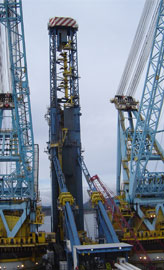One of 2009’s milestones was the launch of the Sakhalin liquefaction plant. In 2010, news concerning the development of the gigantic Shtokman deposit and the associated Barents Sea liquefaction plant surfaced. While design was finished in 2010, the decision to build appears to have been postponed.
It constitutes a strategic decision; one which will maintain the Russian Federation’s level of production capacity, in accordance with domestic consumption and foreseen medium and long-term exports.
Mid-way through the year, the Russian Minister of Energy, in partnership with Gazprom, prepared a new version of the gas development programme through 2030, modifying the 2009 plan. The export market was ascribed a goal of 210 bcm by 2015, as opposed to the 222 bcm established in the previous plan. LNG exports would climb to 24 bcm by 2015 and 35 bcm by 2020.
We have already mentioned that the Nord Stream natural gas pipeline was over halfway built at the end of 2010. The first Russian gas will reach Germany directly in 2011. While this connotes the European market’s heightened dependence on Russian gas, it will also diminish the uncertainty associated with this supply’s fluctuating policy.
Nevertheless, certain doubts concerning the actual construction of the South Stream natural gas pipeline still linger. The project aims to transport 60 bcm of natural gas from around the Caspian Sea under the Black Sea and into Central Europe, via Southeast Europe (Bulgaria, Serbia, Bulgaria), ending up in Austria. Hopes are that construction will begin in 2012. In October, statements from Gazprom spokespeople indicated that this route would start supplying Europe in 2015.
The European Commission has kept up last year’s effort of bringing the Southern Corridor to fruition, Nabucco Project’s main axis. Besides this project, the Southern Corridor entails the construction of other natural gas pipelines, such as the TGII (Turkey-Greece-Italy Interconnector) and the TAP (Turkmenistan-Afghanistan-Pakistan), all of which will transport gas from the Caspian Sea region into Europe. This pipeline’s gas flow towards the continent remains scheduled to begin in late 2014.
The memorandum of understanding between Azerbaijan, Georgia and Romania in mid April accords the pipeline transmission of Azeri natural gas over the Caucasus Mountains and into Georgia. The gas will be subsequently liquefied (LNG) in a terminal situated in Kulei (Dead Sea). The LNG will be shipped in tankers to the Romanian network, where it will be sent to other EU states.
Mid-way through 2010, Gazprom forged an agreement with the private Russian gas-producing company Novatek, to export LNG located in the Yamal Peninsula. This is the first agreement which could result in the mining of resources (some 1,300 bcm) located in the South Tambei gas field and in adjacent deposits. Gas production is scheduled for 2018.

-
 MEDGAZ
MEDGAZ

